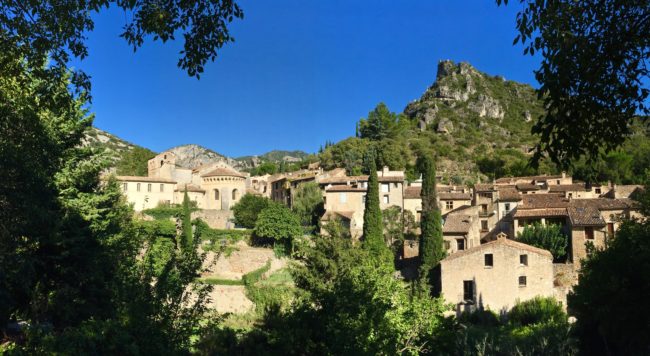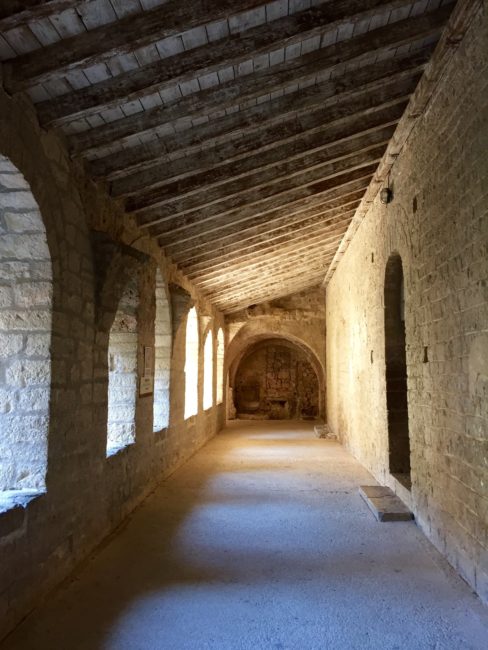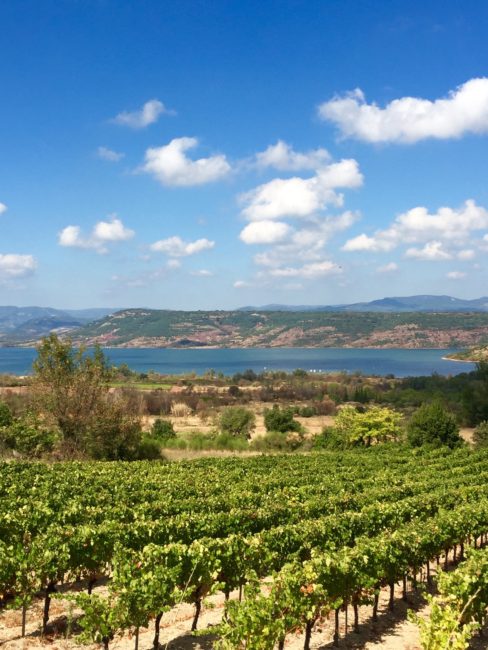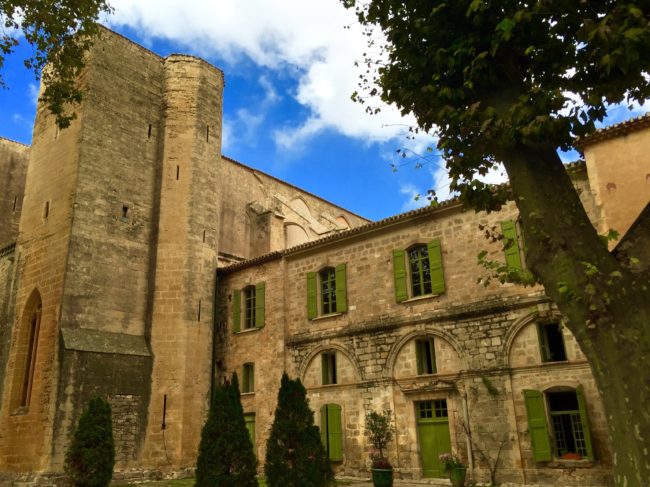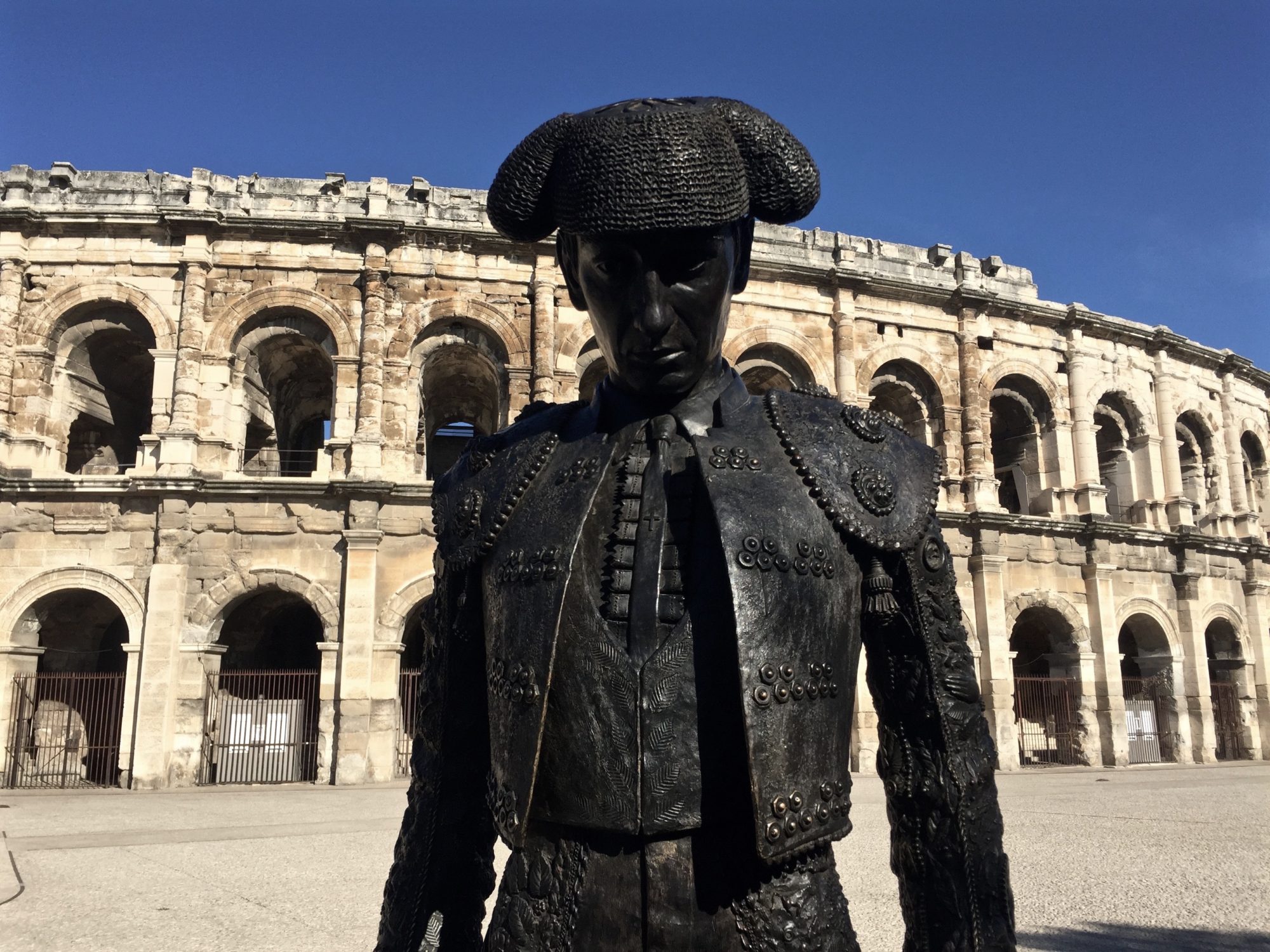
Chapter Ten – Ruins & Doins in Two Historic French Towns
January 9, 2017
Chapter Twelve – Meandering Through Montpellier
January 29, 2017Chapter Eleven – Languedoc Loop
 Day Eleven – Babette’s Feast, Another Old Bridge, UNESCO Abbey That Has Parts In New York, You Mean This Isn’t A Vegas Circus, Old Man Climbing Deterrence: Part Deux, A Lunch Setting Perfect For A Movie, Drive Around The Lac, Wine Salvation, Vats In The Belfry, I Don’t Think We’ll Fit, Rooftop Time, Without A Kir In The World and Dinner on The Square
Day Eleven – Babette’s Feast, Another Old Bridge, UNESCO Abbey That Has Parts In New York, You Mean This Isn’t A Vegas Circus, Old Man Climbing Deterrence: Part Deux, A Lunch Setting Perfect For A Movie, Drive Around The Lac, Wine Salvation, Vats In The Belfry, I Don’t Think We’ll Fit, Rooftop Time, Without A Kir In The World and Dinner on The Square
Eat. Sleep. Eat. It’s tough to travel, especially when your pants are getting tighter and tighter.
Although I hadn’t quite digested that last bite of Baba au rhum from the previous evening, Tracy and I ventured into Babette’s gorgeous salon for our breakfast consisting of chopped fruit, yogurt, ham, cheese, croissants, bread, jam, cereal, tea and coffee…and more bread. At this point, I threw away the number to Jenny Craig…again! I was so busy eating, I had to steal this photo off the internet.
 I had an inclination of the route I wanted to take this day, and Babette added one more sight for us to see on the way back, which turned out to be a winner. Soon, we were off to a desert in a car with no name, where we would be hitting another UNESCO World Heritage site.
I had an inclination of the route I wanted to take this day, and Babette added one more sight for us to see on the way back, which turned out to be a winner. Soon, we were off to a desert in a car with no name, where we would be hitting another UNESCO World Heritage site.
At the outlet of the Hérault Gorges stands Pont du Diablo, which I believe was the name of virtually every bridge built in France in the old days. Construction on this one began in the 11th century by Benedictine monks of the Abbeys of Aniane & Gellone, and it ranks as one of the oldest existing French medieval bridges.
 We took a quick photo from the road and headed to our first destination of the day, Saint-Guilhem-le-Désert. Not knowing we could drive closer, we parked in a lot below (€4.50) and started our trek toward the Abbaye de Gellone and the village that surrounds it in the aptly named Gellon Valley.
We took a quick photo from the road and headed to our first destination of the day, Saint-Guilhem-le-Désert. Not knowing we could drive closer, we parked in a lot below (€4.50) and started our trek toward the Abbaye de Gellone and the village that surrounds it in the aptly named Gellon Valley.
 The town is named after Guilhem, a ninth century Frankish prince, who defeated a Saracen giant named Don Juan who lived in a giant castle (well, where else would a giant live?) above the town.
The town is named after Guilhem, a ninth century Frankish prince, who defeated a Saracen giant named Don Juan who lived in a giant castle (well, where else would a giant live?) above the town.
You couldn’t have painted bluer skies, and soon we saw the abbey in the distance.
We reached the central square, place de la Liberté, which according to notes contains the “largest and widest plane trees in France.” Whenever we see plane trees, Tracy and I always wing it.
We were here to see the Abbaye de Gellone, founded in 804 by the aforementioned Guilhelm of Orange (no relation to Donald Trump), Duke of Aquitaine and second Count of Toulouse, a member of Charlemagne’s court, later known as Saint Guilhem (I would have hated to have to introduce this guy at a party).
The abbey, Hérault Gorge and Pont du Diable make up a UNESCO World Heritage Super Site, which means we get double stamp points on our UNESCO Card, I believe. Once Tracy and I figured out how to open the front door to the abbey (hey, it was a BIG door), we entered the abbey church, which had been reconstructed after the French Revolution.
The interior of the church contains a famed organ, large pillars, a cloister and some medieval rooms.
We did not spend an inordinate amount of time inside on this beautiful day.
Oh, the cloister? Tracy reminded me that some of this abbey’s original cloister and statues now reside in a place we had been to the year before…the Cloisters in New York City (below). One website talks about that acquisition with a disdainful quote that reads: “It is difficult to know who best deserves the title of Most Cretinous Philistine…the people who sold them, those who bought them, or those who now decline to return them.” Touché! (Check out more on the Cloisters from my 2015 report)
In hindsight, we were glad we parked at the bottom of the hill, because on the way back we traversed through the small and lovely streets of Saint-Guilhem-le-Désert.
There were lots of shops, but since virtually nothing opened until 11:30, the town was (in our reoccurring scenario) vacant.
“Serene” would be the word that best described this village.
Back in the car, Tracy said, “Let’s go to the Cirque De Mourèze.”
“Now I like these Vegas-style circus acts as much as the next guy,” I told Tracy, “but we’re here to see scenery!”
 As it turned out, Cirque De Mourèze is just that… a scenic spot. Located about a half hour from Saint-Guilhem-le-Désert, Cirque De Mourèze is “an extensive natural amphitheatre (it covers almost 1000 acres) of dolomites (hard upright rocks that remain standing when water and wind erosion has worn away the softer rock around them). The landscape is most strange and fascinating; the most intact ‘cirque of dolomites’ in Europe.”
As it turned out, Cirque De Mourèze is just that… a scenic spot. Located about a half hour from Saint-Guilhem-le-Désert, Cirque De Mourèze is “an extensive natural amphitheatre (it covers almost 1000 acres) of dolomites (hard upright rocks that remain standing when water and wind erosion has worn away the softer rock around them). The landscape is most strange and fascinating; the most intact ‘cirque of dolomites’ in Europe.”
We parked in the village of Mourèze and started up a path toward the rocks. It was rather a steep climb for an old man, but a nimble spouse kept me at times from falling on my butt, and we made it to an outlook of dolomites.
 However, another path (much steeper) would take “us” to a better vantage point.
However, another path (much steeper) would take “us” to a better vantage point.
 Tracy had not brought a first aid kit and with no reversal agent from my blood thinners invented, should I fall on my noggin’, Tracy decided it would be wise for me to stay behind while she conquered the dolomites.
Tracy had not brought a first aid kit and with no reversal agent from my blood thinners invented, should I fall on my noggin’, Tracy decided it would be wise for me to stay behind while she conquered the dolomites.
 She took some nice photos, while I pondered a gym membership upon my return home.
She took some nice photos, while I pondered a gym membership upon my return home.
 Babette had suggested a cute little town not too far from the Cirque De Mourèze where we might grab a bite for lunch. I deftly drove through an allée of trees to Villeneuvette, a town originally built as a Royal cloth-making factory for King Louis XIV in the 17th century, who never tried to pull the wool over anyone’s eyes.
Babette had suggested a cute little town not too far from the Cirque De Mourèze where we might grab a bite for lunch. I deftly drove through an allée of trees to Villeneuvette, a town originally built as a Royal cloth-making factory for King Louis XIV in the 17th century, who never tried to pull the wool over anyone’s eyes.
 We parked just outside the gate that led into town.
We parked just outside the gate that led into town.
 The are a few “Maisons de Maitre,” where the rich bosses lived, but most of the homes in the area were just pleasant, shuttered abodes. I shuttered to think we might be too late for lunch again.
The are a few “Maisons de Maitre,” where the rich bosses lived, but most of the homes in the area were just pleasant, shuttered abodes. I shuttered to think we might be too late for lunch again.
 For lunch, we went right to La Source.
For lunch, we went right to La Source.
 The plush Hôtel/Restaurant La Source offers a terrace overlooking the garden and pool area of the hotel. I had forgotten to pack my ascot, but we were seated anyway, and the food was very, very good.
The plush Hôtel/Restaurant La Source offers a terrace overlooking the garden and pool area of the hotel. I had forgotten to pack my ascot, but we were seated anyway, and the food was very, very good.
Tracy started with a delicious (I should know since I stole half of it) Chestnut soup with Serrano ham. In honor of our longtime traveling partner Kim, Tracy also ordered a Caesar salad.
 My choice of a filet of pork with a gratin of pumpkin and sweet potatoes was also outstanding.
My choice of a filet of pork with a gratin of pumpkin and sweet potatoes was also outstanding.
 Back in the car, we detoured around Lac-du-Salagou, which actually looks better in the pictures, but offered a nice diversion.
Back in the car, we detoured around Lac-du-Salagou, which actually looks better in the pictures, but offered a nice diversion.
Then we headed on some scenic little roads…love the allées…
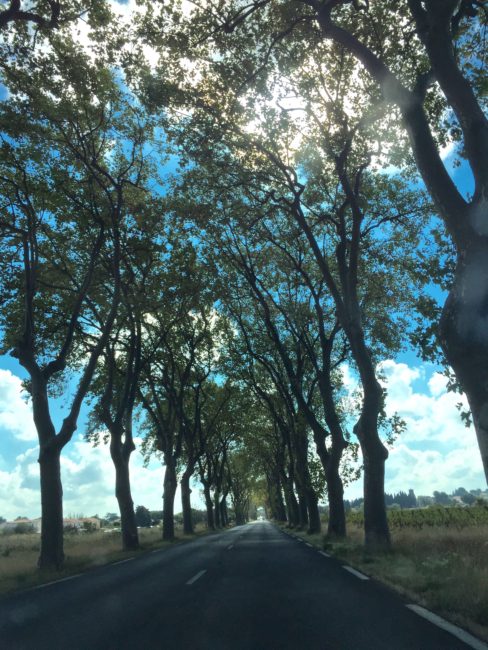 …to the destination Babette had told us about at breakfast.
…to the destination Babette had told us about at breakfast.
The Abbaye de Valmagne is a Cisterian abbey founded in the 12th century that was transformed into a wine cellar after the French Revolution. It is sometimes called the “Cathedral of the Vineyards.”
Amen!
 A little history 101: “At the French Revolution in 1789, the last five monks of Valmagne fled just ahead of rebellious peasants, who ransacked and burned the abbey. In 1791, Valmagne Abbey was sold by the government to a private citizen, who turned into a wine cellar. This unusual use of the abbey church saved it from destruction. The abbey has been beautifully restored and was opened to the public in 1975.”
A little history 101: “At the French Revolution in 1789, the last five monks of Valmagne fled just ahead of rebellious peasants, who ransacked and burned the abbey. In 1791, Valmagne Abbey was sold by the government to a private citizen, who turned into a wine cellar. This unusual use of the abbey church saved it from destruction. The abbey has been beautifully restored and was opened to the public in 1975.”
 It cost €7 each to wander the property that is still owned by the family that purchased it back in 1791.
It cost €7 each to wander the property that is still owned by the family that purchased it back in 1791.
The ambulatory of the Gothic Church contains wine barrels…
 …where I attempted to get a drink, which, of course, would have made me less ambulatory.
…where I attempted to get a drink, which, of course, would have made me less ambulatory.
There is a beautiful fountain in the cloisters…
..and we enjoyed a leisurely stroll through the nooks and crannies of this ancient church. Afterward, we stopped in the tasting room to purchase a couple of bottles, and after a stop in the nearby vineyard…
…we were on our way back to Pézenas. This time we’d have to find the parking area without the assistance of Babette.
Our GPS was doing fine until she sent us down a street (well, more like an alley) that seemed to get narrower and narrower as we moved forward. Finally, and I’m doing this from memory, our GPS shrieked, “What the hell are you doing? Are you trying to kill me? We’re going to scrape the building!” She’s smart…but pushy.
Fortunately, after years of European driving experience, I knew how to put the car in reverse, and we slowly (very slowly) backed through the alleyway, missing by inches a young boy kicking a soccer ball and finally made it back home safely.
Up on the rooftop, we opened our wine and soon Babette checked in on us delivering some snacks she made to go with our wine. She also secured dinner reservations for us at Le Vieux Coq. Have I told you how much we liked Hotel de Vigniamont?
 Le Vieux Coq is located directly on a little square, and we were seated (where else) on the covered patio. No English was spoken, but my one year of high school French got us two kir Royales to start.
Le Vieux Coq is located directly on a little square, and we were seated (where else) on the covered patio. No English was spoken, but my one year of high school French got us two kir Royales to start.
 Dinner was once again excellent. I followed my Melón con jamón (the Serrano ham was heavenly) with excellent tournedos of boeuf wrapped in bacon with roasted potatoes (as did Tracy).
Dinner was once again excellent. I followed my Melón con jamón (the Serrano ham was heavenly) with excellent tournedos of boeuf wrapped in bacon with roasted potatoes (as did Tracy).
 I ended the meal with a dessert of pears in a red wine sauce. Dinner was so good I didn’t even notice the buttons flying off my pants.
I ended the meal with a dessert of pears in a red wine sauce. Dinner was so good I didn’t even notice the buttons flying off my pants.
Afterward, we strolled through the streets of Pézenas in a futile attempt to walk off the thousands of calories we had consumed throughout the day and night.
 Sleep came fast, however, which was good because tomorrow we had a day trip planned to the big city…after breakfast, of course!
Sleep came fast, however, which was good because tomorrow we had a day trip planned to the big city…after breakfast, of course!
Next: Day Twelve – This Drop Off Ain’t No Drop Off, Comedie Central, What’s This Wet Stuff, Monet’s Talented Friend, I Don’t Think You Smoked The Entire Pack Yet, Montpellier Meanderings, We’re #1 & One Of The Joys Of Traveling

